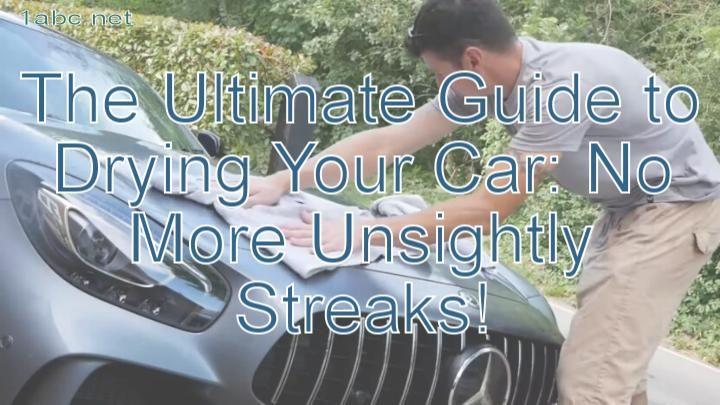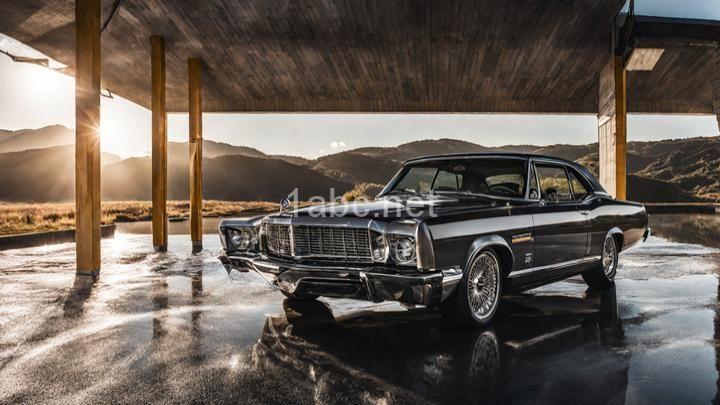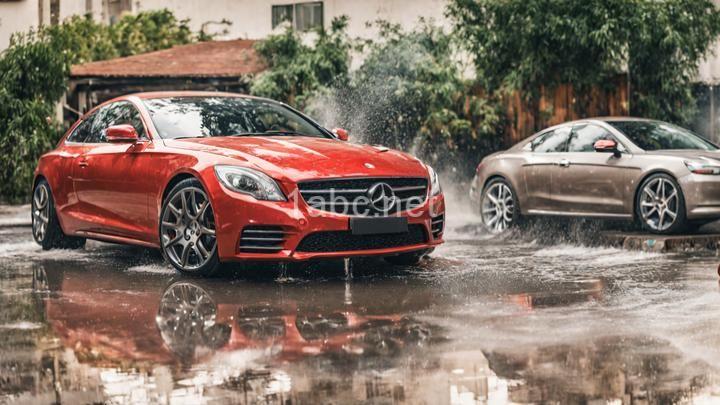The Ultimate Guide to Drying Your Car: No More Unsightly Streaks!
Introduction:
I. Gather the Right Tools:
II. Pre-Drying Steps:
1. Park in a shady area or use a car shade:
2. Rinse off excess water:
III. Proper Drying Techniques:
1. Start from the top down:
2. Use the blotting technique with microfiber towels:
3. Employ waffle-weave drying towels:
4. Utilize a soft squeegee for windows:
IV. Finishing Touches:
Conclusion:

Introduction:
Welcome readers to this ultimate guide to drying cars without leaving any unsightly streaks. We understand the importance of maintaining a spotless and shiny finish on your car, and we're excited to share the best techniques and tools to achieve just that.
I. Gather the Right Tools:
Before we dive into the drying process, it's important to gather the right tools. Here are the essential tools you'll need:
- Microfiber towels: These are a must-have for drying your car. They are soft, absorbent, and gentle on the paint. Look for high-quality, plush microfiber towels that won't leave lint or scratches behind.
- Waffle-weave drying towel: A waffle-weave drying towel is specifically designed to absorb water quickly and efficiently. Its unique texture helps prevent streaks and water spots, making it an excellent choice for drying large surfaces.
- Detailing spray: A good detailing spray is a great addition to your drying routine. It not only adds shine to your car's surface but also provides a layer of protection against dirt, dust, and water.
- Soft squeegee: For the windows and glass surfaces, a soft squeegee will help achieve a streak-free finish without leaving any scratches.
II. Pre-Drying Steps:
Before you start drying your car, there are a few pre-drying steps you should take to ensure the best results:
1. Park in a shady area or use a car shade:
Direct sunlight can cause water to evaporate quickly, leaving behind water spots and streaks. It's best to park your car in a shaded area or use a car shade to protect it from the sun.
2. Rinse off excess water:
Before you begin drying, rinse off any excess water using a hose with a gentle stream or the low-pressure setting at a self-service car wash. This step helps minimize the risk of water spots and mineral deposits.
III. Proper Drying Techniques:
Now that you have all the tools and have taken the necessary pre-drying steps, let's dive into the proper drying techniques:
1. Start from the top down:
To prevent dirt or debris from being carried onto already cleaned surfaces, it's important to work systematically from the top down. Start with the roof, then move to the hood, trunk, and finally the sides and lower panels.
2. Use the blotting technique with microfiber towels:
The blotting technique is the key to achieving a streak-free finish. Gently blot the wet surface with clean microfiber towels, absorbing the moisture without creating excessive friction that could lead to swirl marks or scratches. Remember to fold and flip the towels regularly to ensure maximum effectiveness.
3. Employ waffle-weave drying towels:
Waffle-weave drying towels are excellent at absorbing water quickly and efficiently. Use these towels in long, sweeping motions across larger surfaces like the hood and roof. The waffle texture helps to trap water, reducing the risk of streaks.
4. Utilize a soft squeegee for windows:
For glass surfaces, such as windows and mirrors, a soft squeegee is the way to go. This tool will help you achieve streak-free results without damaging the glass. Start at the top of the window and work your way down, using gentle, even pressure.
IV. Finishing Touches:
To add that extra shine and protection to your freshly dried car, consider using a detailing spray. Apply a quick mist of the detailing spray to the surface and gently buff it in using a clean microfiber towel. This will enhance the overall appearance and help repel water in future washes.
Conclusion:
In conclusion, proper drying techniques are crucial for maintaining a spotless and streak-free finish on your car. By following the steps outlined in this guide and using the right tools, you'll be able to dry your car like a pro every time. Remember, with these helpful guidelines, you'll be able to dry your car like a pro without any unsightly streaks! Happy drying!
FREQUENTLY ASKED QUESTIONS
What is The Ultimate Guide to Drying Your Car: No More Unsightly Streaks!?
"The Ultimate Guide to Drying Your Car: No More Unsightly Streaks!" is a comprehensive guide that provides step-by-step instructions on how to effectively dry your car without leaving any streaks. It covers various techniques, tools, and products that can be used to achieve a spotless and streak-free finish. Whether you are a car enthusiast or simply want to maintain a pristine appearance for your vehicle, this guide is designed to help you achieve professional-level results. With its practical tips and expert advice, you'll be able to say goodbye to unsightly streaks and leave your car looking shiny and clean.
Why should I dry my car after washing it?
Drying your car after washing it is important for several reasons:
- Preventing water spots: When water evaporates from the surface of your car, it can leave behind minerals and contaminants that can cause unsightly water spots. Drying your car helps to remove the water before it has a chance to leave any residue.
- Minimizing streaks and smudges: Towel-drying your car can help to evenly distribute any remaining cleaning products or residue, preventing streaks or smudges from forming on the surface.
- Protecting the paint: Standing water on your car's surface can potentially damage the paint over time, especially if your car is exposed to direct sunlight. By drying your car, you can help to prevent any long-term effects of water damage on the paintwork.
- Maintaining a polished appearance: A properly dried car looks clean and well-maintained. Removing excess water and ensuring a dry surface will help your car to maintain its shine and overall sleek appearance.
To effectively dry your car, you can use a microfiber drying towel or chamois cloth. Start from the top and work your way down, drying one section at a time. Make sure to pay attention to crevices and areas where water might accumulate, such as door handles and side mirrors.
Is there a specific technique to follow when drying a car?
Yes, there are some techniques you can follow when drying a car to ensure a streak-free and shiny finish:
- Start with the right tools: Use a clean and soft microfiber cloth or a drying towel designed specifically for cars. Avoid using old towels or rags that may contain abrasive particles.
- Work from top to bottom: Begin drying the roof of the car and gradually move down to the windows, hood, trunk, and sides. This helps prevent water from running down and causing streaks.
- Pat dry, don't rub: Instead of rubbing the cloth vigorously, gently pat the surface to soak up the water. Rubbing can potentially create scratches.
- Pay attention to nooks and crannies: After drying the main areas, use a smaller towel or a microfiber detailing cloth to dry the harder-to-reach spots like window edges, door handles, and side mirrors.
- Open doors and trunk: If possible, open the doors and trunk to dry the water trapped in the edges and crevices. Be cautious not to scratch the paintwork while doing so.
- Use a blower or air drying tool: As an alternative or in addition to towels, you can use a leaf blower or an air drying tool to remove water from hard-to-reach areas like grills, vents, and gaps between panels.
Remember to avoid drying the car under direct sunlight or in extremely hot conditions, as this can cause water droplets to evaporate quickly and leave behind water spots.
Can I use a leaf blower to dry my car?
Using a leaf blower to dry your car is a popular method among car enthusiasts. It is an effective way to remove water without leaving any scratches or water spots. However, it's important to exercise caution and follow some guidelines. Here's how you can use a leaf blower to dry your car:
- Start with a clean surface: Ensure your car is already clean before using a leaf blower to dry it. Removing any dirt or debris beforehand will prevent scratching.
- Use a soft towel or chamois for initial drying: Before using the leaf blower, gently blot the surfaces with a soft microfiber towel or chamois to remove most of the water.
- Set up the leaf blower: Choose a leaf blower with adjustable speed settings, preferring a lower setting to avoid excessive force. Make sure to use a blower with a nozzle attachment, as it helps concentrate the airflow.
- Begin the drying process: Starting from the top of your car, gradually move the blower across the surface, working your way down. Aim the airflow in a controlled manner, keeping a distance of about a foot away from your car's surface.
- Pay attention to crevices and tight areas: Use the leaf blower to blow out water from areas like mirrors, door handles, and gaps between panels. Be careful not to direct the airflow directly at sensitive components like the engine bay or exhaust.
- Finish with a microfiber towel: Once you've removed most of the water with the leaf blower, use a clean and dry microfiber towel to gently dry any remaining damp areas.
Remember, while using a leaf blower to dry your car can be convenient and efficient, always exercise caution to avoid causing any damage or injury.
Will using a microfiber towel prevent streaks?
Yes, using a microfiber towel can help prevent streaks. Microfiber towels have a unique surface texture that is highly effective at grabbing and trapping dirt, dust, and other particles without leaving behind lint or streaks. This makes them ideal for tasks that require streak-free cleaning, such as cleaning glass, mirrors, and other smooth surfaces. When using a microfiber towel, make sure to use it in a clean and dry condition to maximize its streak-preventing properties.
Are there any tips for drying hard-to-reach areas on a car?
Yes, drying hard-to-reach areas on a car can be a bit tricky. Here are a few tips to help you with this task:
- Microfiber towels: Use soft, absorbent microfiber towels to avoid scratching the car's surface while drying hard-to-reach areas. Microfiber towels are gentle and can help to safely remove moisture.
- Compressed air: Consider using a compressed air gun or a handheld air blower to blow out excess water from narrow crevices and hard-to-reach areas. Be cautious not to use too much force or hold the air stream too close to the car's surface to prevent any damage.
- Drying aids: Apply a quick-detailing spray or a drying aid to help remove water droplets from hard-to-reach areas. These products usually have a high lubricity, making it easier for the towel to glide over the surface and remove moisture.
- Flexible drying tools: Look for drying tools designed specifically for hard-to-reach areas, such as flexible drying wands or chamois with long handles. These tools can help you access tight spaces and corners more easily.
- Patience and attention to detail: Take your time and pay attention to every nook and cranny. It's essential to dry the entire surface thoroughly to prevent water spots or potential damage from moisture accumulation.
Remember to always follow proper car care techniques and use the appropriate tools and products for drying to ensure the best results and maintain the overall appearance of your vehicle.
How can I maintain the shine and finish of my car after drying it?
To maintain the shine and finish of your car after drying it, you can follow these steps:
- Wash your car using a pH-neutral car wash soap and a soft sponge or microfiber cloth. Avoid using household detergents or abrasive materials, as they can damage the paint.
- After washing, rinse the car thoroughly with clean water to ensure all soap residue is removed.
- Dry the car using a clean microfiber cloth or chamois. This will help prevent water spots and streaks.
- Apply a coat of wax or polish to protect the paint and enhance the shine. Use a high-quality car wax or polish that is suitable for your vehicle's paint type.
- Follow the instructions on the wax or polish product for the best results. Typically, you would pour a small amount onto an applicator pad or cloth and apply it in circular motions.
- Allow the wax or polish to dry according to the recommended time. This may vary depending on the product you are using.
- Once the wax or polish is dry, use a clean microfiber cloth to buff the surface in circular motions. This will help to bring out the shine and remove any residue.
- Regularly wash and wax your car to maintain its shine and protect the paint from environmental factors.
By following these steps, you can help maintain the shine and finish of your car, keeping it looking great for longer.
How can I dry my car without leaving streaks?
To dry your car without leaving streaks, you can follow these simple steps:
- Start with a clean and soft microfiber drying towel. Avoid using regular towels or cloths, as they can leave lint or scratch the surface of your car.
- Begin by removing excess water from the car's surface using a gentle stream of water from a hose or a rinseless wash solution.
- Use the drying towel to gently pat dry the car's surface. Avoid rubbing the towel vigorously, as this can cause streaks or swirl marks.
- Work from top to bottom in small sections, ensuring that you completely dry each section before moving on to the next.
- If you notice any stubborn water spots or streaks, you can use a quick detailer spray or a gentle car wax to gently buff them away with a clean microfiber cloth.
- Pay special attention to areas where water tends to accumulate, such as around mirrors, door handles, or trim.
Remember, it's best to dry your car in a shaded area or during cooler hours to prevent water from evaporating quickly and leaving behind streaks. Using a quality drying towel and taking your time will help ensure a streak-free finish.




